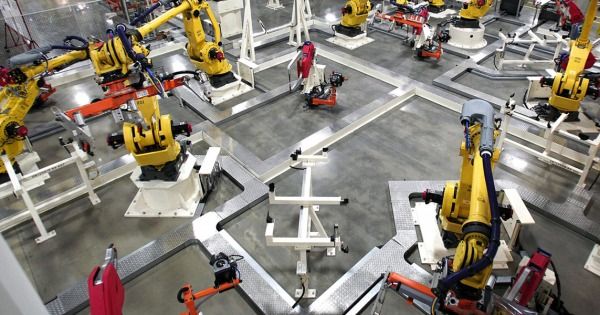Page 10988
Jan 18, 2017
This Might Be The HIV Cure We’ve Been Waiting For
Posted by Shane Hinshaw in category: biotech/medical
Jan 18, 2017
In the Future, We’ll Use Our Phones to Detect Disease
Posted by Shane Hinshaw in categories: biotech/medical, mobile phones
Jan 18, 2017
Automation and Robots Could Permanently Disrupt Capitalism
Posted by Shane Hinshaw in categories: employment, robotics/AI
While some may be able to coast into office with the promise of bringing jobs back from oversees, they fail to realize that there may be no jobs to bring back. Automation is set to replace 5 million human jobs by 2020, with poorer countries being impacted significantly more than developed nations.
Jan 18, 2017
Sci-fi medical clinic opens in San Francisco
Posted by Klaus Baldauf in categories: biotech/medical, privacy, robotics/AI
Resembling something that looks more like an Apple store than a traditional doctor’s office, Forward proposes an entirely different approach to healthcare, with unlimited access to the clinic’s medical resources through a single monthly membership fee.
Upon arriving at a Forward clinic, members sign in on an iPad and enter a custom-designed body scanner. The device immediately processes a variety of biometric data which can be accessed by members through an app on their phone.
Things get even more futuristic when you move into the clinic’s exam rooms. Faced with a giant touch screen display on the wall integrating your medical history and recent biometric data, the doctor can discuss any imminent healthcare issues while an AI system monitors the conversation and instantly displays notes and suggested treatment plans.
Jan 18, 2017
The US Army wants to create biodegradable bullets that plant flowers where they fall
Posted by Karen Hurst in category: military
Flower Power!
As you well know, bullets are designed to kill people. So far, so bad, but the metallic compounds in them also tend to leach into the environment and kill off plants and wildlife too.
At training facilities the world over, the US Army uses live ammunition to gear up their soldiers for combat. These bullets just remain in the wild, and do their damage. Deciding that enough is enough, officials are now asking for proposals to design biodegradable bullets that shall harm the environment no more.
Jan 18, 2017
Made In Space and Axiom Space Announce Joint Agreement for Manufacturing in Low Earth Orbit
Posted by Klaus Baldauf in categories: 3D printing, energy, space
HOUSTON, Jan. 18, 2017 /PRNewswire/ — Made In Space and Axiom Space today, announce an agreement to be users and providers of one another’s capabilities to manufacture products in space. Made In Space is the only company to produce 3D printed products in Space and Axiom Space is the leading developer of the world’s first privately-owned commercial space station. This collaboration signifies Made In Space’s exciting transition from research phase, to manufacturing for commercial customers.
The companies have been working out the logistical elements of in-space manufacturing, outfitting the in-space factory with equipment, utilities, power, and thermal management to answer customers’ growing demand. In parallel to the manufacturing element, the companies are working together to plan the delivery of completed products to Earth, ensuring their quality during flight and upon arrival.
Jan 18, 2017
“The Black Hole That Gave Birth to the Universe” — (Weekend “Galaxy” Stream)
Posted by Andreas Matt in categories: cosmology, physics

The big bang poses a big question: if it was indeed the cataclysm that blasted our universe into existence 13.7 billion years ago, what sparked it? Three researchers at the Perimeter Institute for Theoretical Physics and the University of Waterloo propose that the big bang could be the three-dimensional “mirage” of a collapsing star in a universe profoundly different than our own.
Jan 18, 2017
Forget blood transfusions, the fountain of youth could be closer to hand
Posted by Steve Hill in categories: biotech/medical, health, life extension
It seems more likely what you remove is more important than what you add with old blood.
The evidence is increasingly suggesting that dilution of pro-aging signals is why we are seeing rejuvenation when blood is exchanged between young and old animals. Forget transfusions the next step is to filter our own blood to promote health as we age.
#aging #crowdfundthecure
Continue reading “Forget blood transfusions, the fountain of youth could be closer to hand” »
Jan 18, 2017
Stem Cells Are Poised to Change Health and Medicine Forever
Posted by Klaus Baldauf in categories: biotech/medical, health, life extension
We are at the cusp of a stem cell revolution.
Understanding and harnessing these unique cells may unlock breakthroughs in longevity and therapeutic solutions to all kinds of chronic diseases and regenerative opportunities.
Last month, I took a trip down to the Stem Cell Institute in Panama City with Dr. Bob Hariri (co-Founder of Human Longevity Inc.) to get stem cell injections in my knee and shoulder as an alternative to reconstructive surgery.
Continue reading “Stem Cells Are Poised to Change Health and Medicine Forever” »
















